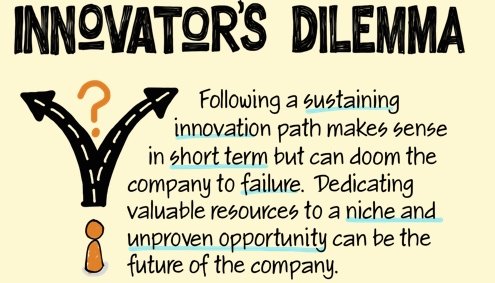 Exercise
Exercise
Tap all the highlighted words in the text below to see their definition. ⇩The Innovator’s Dilemma is a must-read book for anyone minimally involved in entrepreneurship, innovation or business management. It has been considered one of the 6 most important business books ever written by “The Economist”. It was written by Clayton M. Christensen, a Harvard Business School professor, in 1997.
It addresses a dilemma and also a contradiction that has made me think for years, which is the fact that major successful corporations are the most likely to die when faced with new technologies. The same elements that make some companies great will secure their likely failure at some point.

What’s this Dilemma?
The first thing we need to understand is the fact that, during the last 30 years, the business world has been and continues to be disrupted at a faster scale by more new technologies every day. Then, we have split these new technologies into two groups,
1. Sustaining Technologies: These have been important and somehow game-changers. But to some extent, they’ve helped improve something, not break it. These have been the technologies that bring evolution. The hybrid Toyota Prius car has brought tons of sustaining technologies. Mobile touchscreens have been another good example along with the computer mouse or tablets.
2. Disruptive technologies: Only 1 out of 1.000 candidates will likely become disruptive. Here we are talking about a revolution, a new industry and a new society with it. Tesla electrical cars, the Internet itself, the iPhone, and artificial intelligence.

Here’s the problem: It’s very unlikely that a successful company will be the one embracing, investing or discovering new disruptive technologies which is why it will possibly end up going out of business because of them. We just need to look at our past to understand this. The companies that have adopted great disruptive technologies were pretty much new at the time and not the bigger players.
Why does this happen?
There is a number of factors to take into consideration here.
1. When you have become a market leader with billions of revenue and thousands of people on your team, you will take very rational decisions regarding where you invest. You will invest in technologies where the return and benefit is clear and continuous with what you have. It’s easier to measure and easier to explain. Why should a successful company seriously invest in something that crazy that doesn’t allow you to create business models around it and that could destroy your own product or services?
2. Serious leading companies have focused their priorities on their clients and trying to understand what they want. This is the perfect process to progressively improve, but by looking at what your clients want, you do not find what they don’t know they want yet. This is where disruptive technologies lie.
3. On top of that, disruptive technologies, before they really disrupt, do not improve but can actually make things worse, less productive and more expensive. It has taken a lot of time for them to develop and compete with sustaining technologies. Why should a leading firm invest in this?
Instead, a new visionary startup does not have much to lose and has less explanations to give. So their possibilities to innovate and try what could be seen as naive and impossible is not that hard.
Why is Tesla and not Ford a revolutionary company that has pushed the electrical car?
Why is Apple and not Nokia, the company that has made the iPhone?

What have new companies done about it?
Things have changed and today’s leading firms that came out of disruptive moments (Google, Apple, Amazon, Facebook, Microsoft…) seem to have learned an important lesson from it and have clear ideas about the risks of the Innovator’s Dilemma. This is why these companies are investing in new technologies out of their regular scope and purchasing other startups that could threaten their kingdoms. Artificial Intelligence, Quantum Computing, 3D printing, etc.
We will see if, within the next 10 years, they overcome this historical fate and remain successful or if they still fail when faced with more disruptive players, validating once more the logic of the Innovator’s Dilemma.
Grammar – Present Perfect 
See more
Present Perfect
- The present perfect simple expresses something that started in the past and still continues today.
We form it with the verb “to have” in the Present Simple (have or has) followed by the past participle. For example:
I have lived in Barcelona for 10 years.
She has learned a lot in her English class.
Related Course Units
Go back to unit 4 to complete all 6 microlessons.


Thanks! I like ir
🙂
Hi Marc,
Very good, excellent content – current and provocative. In an increasingly complex business world, understanding these new variables is essential for career development. Thank you.
Thank you so much for sharing! 🙂
always great subjects! Thanks
You’re so welcome!
Do you Know the case of Facebook whos try to getting innovation and disruptive financial markets? Then, They build one IA who learn or creative new codes and coming investment who nobody understood. I don’t know if was a urban legend…. but it’s clear that innovator’s dilemma!
Thanks for sharing.
It’s so interesting about how technology is improving. The future is here.
It sure is.